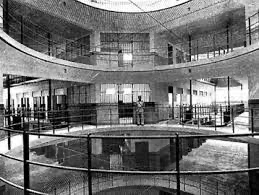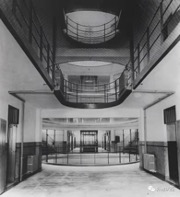Ward Road Gaol, also known as Tilanqiao prison, locates in the Hongkou district of Shanghai. It was one of the first modern prisons in China. Ward Road Gaol was proposed by Shanghai Municipal Council in order to complement Shanghai Municipal Police so that SMP could have charge of the post-conviction treatment of all offenders without relying on others.1 The other motivation for building this new prison is that it was “in the interest of civilization so that China might learn that punishment can be effectual without the employment of barbarous methods which are in vogue throughout the Empire.”, said the British Mixed Court Assessor.2 It was a means to show the advanced prison system of the West and a step to modernise Shanghai. Therefore, Ward Road Gaol differed from the conventional jails in the late Qing period. It was designed and operated by British and Singaporeans, modelling on the structure of western prisons and management systems. However, the motivation of showing the power and advantage of modernization did not get the expected results of the British bureaucrats located in Shanghai. The gaol had experienced failure of administration, problems of mistreatment of prisoners and conflict between the regulations of Chinese and western laws. The gaol shared a similar destiny with Shanghai itself, the transplanted western modernization projects and ideas, and the local reaction and chaos created by this imposed modernity. This blog will explore Ward Road Gaol as a miniature of Shanghai in the early twentieth century.
 |
 |
|
Figure 1 |
Figure 2: (source: Waitanyixi) |
The intended establishment of modernity of Ward Road Goal was revealed by its architectural construction and administrative system. The building of the prison was in the shape of a cruciform, the intersecting point of the cruciform is the only source of natural light. Figures 1 and 2 also show that this architectural design enabled warders to monitor prisoners from different levels. The spatial arrangement of Ward Road Gaol is what Bentham called a “panopticon”. As Foucault argues, the panopticon’s main function is to monitor the behaviour of prisoners. It is a non-violent way to discipline prisoners.3 The principle of using a panopticon as a disciplining method is different from the principal method used to manage prisoners in a conventional Chinese prison. A traditional Chinese gaol emphasized the application of cruel physical punishment as a deterrent to prisoners. Torturing their bodies was believed to be an efficient means to punish people who are charged with guilt.4 Though Ward Road Gaol aimed to become a modern and ‘civilized’ gaol in China, violence towards convicts was not rare. The discipline was still vigorous. There were medical reports on the assaults of warders on the prisoners. The cause of this situation may be approached from two aspects.
For Chinese warders, treating prisoners violently could be an inheritance from the traditional prison management method. Since Ward Road Gaol was one of the very first modern prisons in China. It was hard to change the long-lived persistent habits. The other cause of it could be the existence of racial hierarchy in Shanghai as a mixed-ethnicity international settlement. Isabelle Jackson observed that violence towards local people was common in the Shanghai police system among Sikh policemen, who were considered to have a higher status than local Chinese. Indians were also hired as warders in Ward Road Gaol by the British.5 According to one of the prisoners’ complaints, Indian warders were called, and allegedly gave more than ten slaps and a punch to a Chinese prisoner who gave his diet to one of his fellows.6
This hierarchical power dynamic did not only exist between prisoners and warders, but also among prisoners themselves. Prisoners of different nationalities could receive different treatments. Extraterritorial prisoners enjoyed more privilege than non-extraterritorial prisoners such as Russian, German and Polish. Similar to what happened to the Shanghai police system that there was more than one force operated in this city, prisoners could be regulated and sentenced by different courts and laws, but sometimes be held in the same prison. Extraterritorial prisoners were allowed to have meetings with their family and friends, their families could send food and letters to them at least once a month. However, non-extraterritorial prisoners did not receive equal treatment, thus non-extraterritorial prisoners somehow turned into “white slaves”.7 The mixture of different legal regulations and the identity of prisoners catalyzed the reshaping of the hierarchy which was different from the world outside of the prison. These hierarchies in prisons also reflect the hierarchy of the whole city.
Therefore, the small and isolated world in Ward Road Goal reflected the contemporary situation in Shanghai, such as the difficulty of adapting western practices to an eastern context, the new racial hierarchy among people of different ethnicities, and the chaos of jurisdiction and confusion created by extraterritoriality. In addition, there was a strike that took place in Ward Road Gaol led by the Indian warders, which matches what Jackson has mentioned that there was a rising of nationalism among the Indians who worked in Shanghai. The intention of building a modern prison in China companies with the defects of modernization of prison and of Shanghai as a city.
Nowadays, Ward Road Gaol is more frequently seen as a symbol of the strong will and firm faith held by activists, intelligent and patriots who were arrested and contained in the prison through the propagandization of the media and the government, and a representation of elite, since it is now used to contain people who committed financial crimes. Also, it is now listed in the urban planning schedule, waiting to be removed, in order to build a new cultural park at its original site.
- Frank Dikötter, Crime, Punishment, and the Prison in Modern China (New York: Columbia University Press, 2002), p. 308. [↩]
- Ibid, p.308. [↩]
- Michel Foucault, Discipline and Punishment, part 4. [↩]
- Li Wenbing, Zhongguogudaijianyushi, p. 148-149. [↩]
- Isabella Jackson, “The Raj on Nanjing Road: Sikh Policemen in Treaty-Port Shanghai,” Modern Asian Studies 46, no. 06 (November 2012), p. 1690-1691. [↩]
- Frank Dikötter, Crime, Punishment, and the Prison in Modern China, p. 318. [↩]
- Ibid, p. 322. [↩]